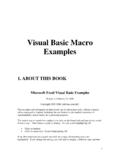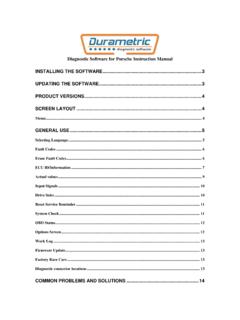Transcription of Pipeline M&R Station Automation Using Kingfisher …
1 Io 8 (877) 343 8467 Pipeline M&R Station Automation Using Kingfisher Introduction Metering and regulating (M&R) Station Automation in the natural gas Pipeline industry is among the common applications of Semaphore s Kingfisher RTU products. While the G30 is suitable for smaller stations employing one or two meter runs, the modular, expandable, Kingfisher Plus+ can fully automate a much larger Station . It can input live data and analysis information from BTU analyzers and chromatographs; perform all flow calculations, data base management, run switching, and flow/pressure control; and interface with a SCADA network, local PC, smart transmitters, and a customer network. M&R Station Overview M&R stations are employed by gas Pipeline and distribution companies to measure gas flow and to regulate gas flow and gas line pressure.
2 Today, various meters are employed and include orifice, positive displacement (PD), turbine, ultrasonic and Coriolis. In the case of the orifice meter, the primary flow measurement is obtained by measuring the differential pressure across the orifice plate. When provided with electrical pickups, PD meters output pulses whose count is proportional to gas volume. Turbine meters output a train of pulses whose frequency is proportional to the volume. Ultrasonic meters emulate turbine meters with a frequency but also provide the same information via a serial interface. Coriolis meters provide frequency, analog or serial signals; however, their output is proportional to mass flow rather than volume. Measuring flow is not as easy as it first appears. All meters (except, in theory, Coriolis) require correction.
3 Flow isn t merely measured; it is calculated. Correction factors, which account for the physical properties of gas, as well as the meter tube, itself, make up numerous terms in corrected flow equations. Gas line pressure and temperature provide the two, most important correction factors. Many M&R stations are fiscal metering or custody transfer points, where the natural gas changes hands (or, custody) from one legal entity to another. The gas measurement will be used as the basis for billing. This makes the measurement function and, therefore, the instrumentation at the Station , critical. Typical control function at M&R stations include operation of one or more, flow control valves or pressure regulators, opening and closing valves to activate or deactivate individual meter tubes and operation of an odorizer.
4 Io 8 (877) 343 8467 Description of M&R Station Functions Regular Control Operating pressures within local distribution utilities, industrial users and power plants are typically much lower than the hundreds or over 1000 psi operating pressure in a gas transmission system. One or more pressure regulators are used to reduce the line pressure to a level that is appropriate to the user at the outlet of the Station . The Kingfisher RTU can provide a pressure set point, via an analog output, to an electric actuator or pneumatic regulator that operates the valves. Run Switching The M&R Station in the diagram includes three meter tubes (runs) in parallel. The main reason multiple runs are used is range ability. Using differential pressure measurement across an orifice plate, the turn down of a meter tube is limited to about 3:1.
5 The gas industry has found it better to use multiple, smaller meter tubes rather than one, large tube able to handle the full range of gas volume. Run switching consists of opening and closing a run switching valve which, respectively, cuts in or cutsout a meter tube. Run #1, the primary run, normally has a manual valve while the rest of the runs have solenoid valves which can be operated by the RTU. As the flow nears the upper range DP limit for run #1, the RTU sends a command to open the valve for run #2. Now, with two runs in operation, the DP for both will be closer to mid range. Runs #3 and #4 will be cut in if the DP for the preceding range exceeds a pre set limit. Conversely, runs are cut out when the DP sinks below a preset low limit. To account for range ability on the low end, very low flow with only run #1 cut in, the industry has traditionally resorted to stacked DP transmitters.
6 Two transmitters, with different ranges, are installed. The RTU chooses the transmitter with the best range for the DP input value at the time. Recently, with more accurate, smart transmitters available, stacked DPs have been much less common. While this discussion has addressed a Station with all orifice meters, some recent installations have included turbine or ultrasonic meters on the primary run with orifice meters on additional runs. Particularly for low flows, this takes full advantage of the better range ability of the turbine or ultrasonic meter. The Kingfisher RTU can accommodate a mixture of orifice and turbine or ultrasonic meters, at the Station . Io 8 (877) 343 8467 Primary Measurement InputsEach meter tube has a DP transmitter connected to the flanges on either side of the orifice plate.
7 A stacked DP, on run #1, is unusual in new installations. On the Kingfisher G30 or Kingfisher Plus+, the DP transmitters interface via analog inputs. If turbine meters were used in place of the orifice meters, high speed counter inputs would be used in place of the analog inputs and DP transmitters. The primary corrections are provided by the line pressure and temperature inputs. Normally, only a single pressure and temperature are required per meter run. Gas Flow and Energy Calculations Using the DP (or counter), pressure, and temperature inputs, the Kingfisher RTU performs corrected flow calculations according to the American Gas Association (AGA). These calculations are described in comprehensive reports that are available from the AGA. In the Kingfisher products, the AGA calculations are provided by preconfigured function blocks: AGA3 Report for orifice meters.
8 AGA5 BTU energy content calculation. AGA7 Report for turbine and PD meters. AGA9 Report for ultrasonic metering with the same calculations as AGA7. AGA11 Report for Coriolis metering. Compressibility or super compressibility calculations are used in conjunction with AGA3 or AGA7: NX19 Super compressibility. AGA8 Compressibility Using gross and detailed methods. In the RTU, individual flow calculations are done, per meter run, with the results added together to derive the flow for the Station . Flow/Pressure Control The Kingfisher RTU can perform auto selector flow/pressure control. Typically, the control valve is downstream of the meter tubes. Many applications call for the gas customer to provide a flow set point based on his requirements. Otherwise, the flow set point is based on a custody transfer contract.
9 In the auto selector algorithm, the RTU normally operates the valve to regulate flow, as calculated by AGA3 or AGA7. However, it also monitors the line or discharge pressure. If the pressure exceeds a high limit, it willthen operate the valve to regulate 8 (877 ) 343 8467 DownstreThe downstis connectesafety requimportant. measuremeabove. Sampler CIdeally, natsuch as carbthese otherof the gas. Tthe gas and One way is open the vadiscrete outflow). Periodically Live BTU AMore oftenis impossiblBTU heating7 eam Gas Mtream, or dd. This is a direments foThe dischargent. NormallControl ural gas is pubon dioxide,r componentTherefore, pd determine to connect aalve to injecttput, can bey, the gas coAnalysis n, today, the le Using samg value is inpMeasuremeischarge endistribution ur gas lines oge pressure ly, this is theure methane, nitrogen, ats affects thpipelines andthe heating a sampler bot a sample oe time basedmpany remoindustry reqmpler bottlesput to the RTentsnd of the meutility, power industrial btransmittere pressure vae.
10 In reality, nd a varietye heating vd distributiovalue. ottle, througof gas into thd or flow basoves the botquires a nea, a BTU analTU via an aneter Station er plant or laburners, preprovides thariable usedgas includesy of hydrocarvalue, or then utilities negh a valve, tohe bottle. Thsed (where tttle and tranr instantaneyzer could bnalog input. wwwis where thearge industriessure regulae downstread by the regus a number rbons such ae energy coneed to perfoo the line. The pulse outpthe pulse frensports it to eous heatingbe installed gas customal user of gaation is extream line presulator in the of other comas ethane. Thntent (measrm a chemiche RTU can pput, provideequency depa laboratoryg value analyright at the mer s systemas. To meet emely ssure description,mponents, he amount oured in BTUcal analysis operiodically d by a pends on gasy for analysisysis.))











